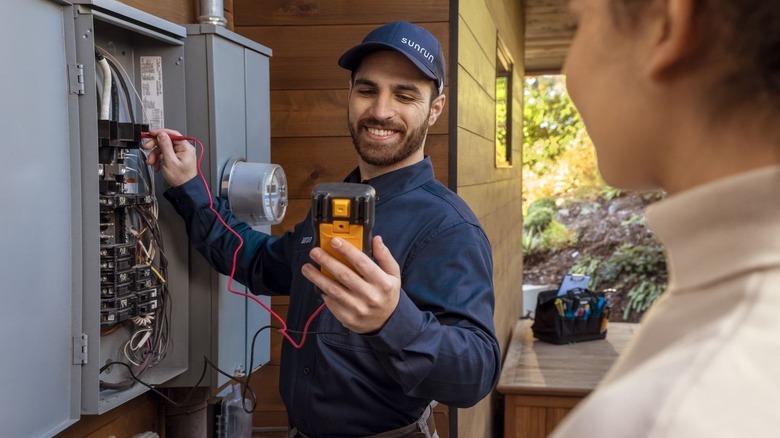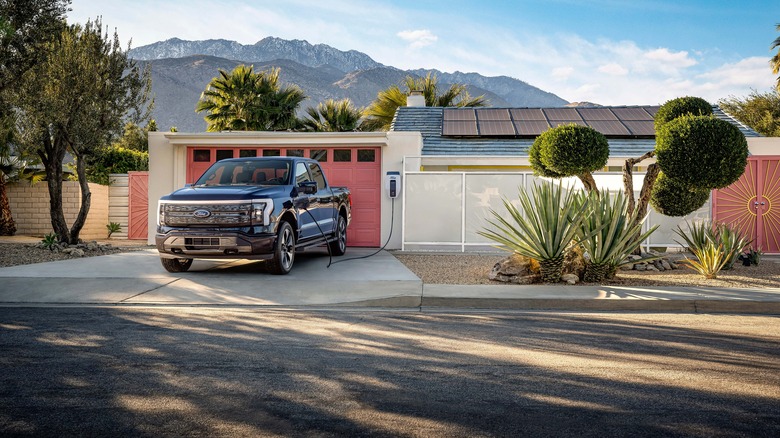Ford's Electric Pickup Can Power Your House In An Outage, But The Cost Could Be Eye-Watering
The Ford F-150 Lightning is an incredible feat of engineering. Though some truck owners scoffed at the thought of replacing thirsty diesel and gas engines with a more environmentally friendly motor, it actually won a lot of people over. The specs and hype led to a situation where the trucks were impossible to get hold of and Ford even had to threaten dealers who were price gouging and even selling their demonstration models for a huge profit. As things stand, orders have been suspended for the 2023 edition of the vehicle, as the company struggles to meet demand. But when you look at the specs sheet, things start to make sense. The F-150 Lightning has the equivalent of 580 horsepower, can produce 775 lb-ft of torque, and can get from 0-60 faster than most sports cars. The basic model offers around 240 miles of range between charges, and the extended range version can hit 320.
On top of everything else, Ford's electric truck has a very unique feature, and it isn't related to towing, storage space, or top speed. The Michigan-based motor company claims you can use its truck's massive batteries to power an entire house for a significant amount of time. On paper, that's a major selling point and something that could put the F-150 Lightning way ahead of other trucks like the upcoming Electric Dodge Ram and the "should be here by now but still upcoming" Tesla Cybertruck. Unfortunately, as with most food things, there's a fairly significant catch.
Powering your house with an electric truck is pricey
If you want to power your home with a Ford F-150 Lightning, you can't just plug it into the wall. You'll need to have some work done, According to Motor Trend, an optimistic price would be around $11,000 but could cost significantly more. The first thing you need is an F-150 Lightning and Ford's Charge Station Pro Level 2 charger, which you get for free when you purchase an extended range version of the electric truck. If you aren't getting a free one, the charge station is going to set you back $1,310.00 plus tax on its own. While the Charge Station Pro will allow you to fast charge your truck at home, simply hooking it up won't allow the F-150 Lightning to power your house.
If you actually want to use the F-150 Lightning as a backup home power supply, you're going to have to deal with Ford's "Preferred Installer," Sunrun. You don't actually have to use Sunrun to set the system up. You can hire a local electrician or do it yourself if it's legal where you are, and you have the know-how, but you will need to purchase some equipment from Sunrun either way. "Home Integration System hardware" is required and this can only be purchased through Sunrun. The hardware is priced at $3,895, but that figure only gets you a cardboard box full of parts. You're also likely to need a bunch of permits and "local utility co-ordination" before your F-150 Lightning is truly part of the grid.
Hidden labor and upgrade fees could see the cost increase drastically
If you decide to go the simple route and have Sunrun install your Home Integration System Hardware, like Ford recommends you do, then make sure your checkbook is ready to go. A writer from MotorTrend went through the process of getting a quote, and found you may end up paying more than you initially budgeted. The website claims that installing the Charge Station Pro charger (which they received free with the truck they bought) costs $1,650. Adding in the Home Integration System Hardware and installing that too bumps the price up to $9,400. But unless your home meets Sunrun's requirements, you'll be paying more than that.
A clause in the contracts the article's writer, Christian Seabaugh, received stated "We (Sunrun) may find that your home requires additional work or upgrades to make it suitable for the Equipment ('Home Upgrades'). For example, your main electrical panel may need to be upgraded to be able to handle the additional power for the Equipment. If your home needs Home Upgrades, we'll provide you with written notice."
Despite an initial inspection suggesting the installation could go ahead without much additional work, Seabaugh received a final quote of $17,340 to get the necessary equipment installed to allow him to use his F-150 Lightning as a backup generator. The costs included an upgraded electrical panel, the relocation of some circuits, and $1,600 set aside for some very vague "other work." Seabaugh instead opted for a third-party Level 2 charging station, and an independent electrician to install it.
Despite the cost, there are benefits
While setting up the system could require significant investment, there are some benefits to using one of the F-150 Lightning's most unique features. The main one is peace of mind. Ford says the extended range model of the Ford F-150 Lightning has enough in the "tank" to power the average American home for over three days. That can also be stretched out up to ten days if your usage is "properly rationed." According to the U.S. Government, the average household experienced around eight hours of power outages in 2020, which was the most on record. If an F-150 Lightning was hooked up to the average house, the total annual outage time wouldn't even make a dent in its power reserves.
But the feature isn't only useful when things go awry. Theoretically, it could help your home become energy independent if you have your own green energy source like solar panels or a small windmill. The sun doesn't always shine, and the wind doesn't always blow, but your truck could be used to store excess energy, which you can then use during the night. Then there's another unique feature Ford says its truck will one day have — Intelligent Power. This feature should allow users to employ their truck as an energy source during peak hours, when demand and electricity prices are higher. The truck will then recharge during off-peak hours, when electricity is cheaper. This should theoretically save the customer money and reduce strain on the power grid. How long it would take to "pay for itself" though, has yet to be seen. As things stand, you may be better off with a Tesla Powerwall.


